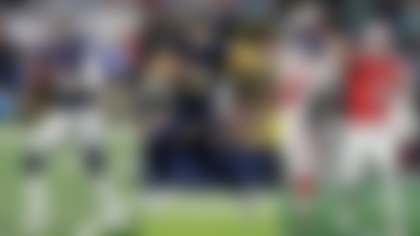Which teams got it right on fourth-down and 2-point conversion calls in Week 12 of the 2021 NFL season -- and which teams got it wrong? The Next Gen Stats analytics team uses the Next Gen Stats Decision Guide powered by AWS to break down the numbers behind the decisions that shaped the game.

Sean McVay wavers on fourth down
Going into Week 12, there were just two NFL head coaches who had yet to go for it on fourth down inside their own territory this season: Bill Belichick and McVay. Over the Rams' first 10 games, they faced three fourth-down decisions inside their own territory where the NGS Decision Guide recommended going for it by more than 1 percentage point in win probability value, and they punted all three times. During Sunday's crucial road game in Lambeau Field, though, McVay and Co. broke with this trend:
FIRST QUARTER: With 27 seconds remaining and the Rams (trailing 7-0) facing a fourth-and-inches from their own 29-yard line, Darrell Henderson is stopped for no gain by Adrian Amos, and the Packers take over on downs.
The guide supported McVay's decision to go for it in this situation; keeping the offense on the field increased the Rams' chances of winning by 1.2 percentage points more than if they'd punted. The offense had less than a full yard to gain for the first down (0.5 yards, to be exact, according to NGS ball-tracking data), which equated to a 79 percent conversion probability, according to our model.
Yes, the play failed, but that just makes it another case of right process, wrong outcome when it comes to fourth-down decision-making. That said, one wonders if the result impacted McVay's willingness to go for it for the rest of the game. Two possessions later, the Rams faced a fourth-and-2 from their own 41-yard line, which our numbers pegged as an even stronger go for it situation (the guide recommended the team go for it by 2.3 percentage points), but they decided to punt -- a suboptimal call, regardless of the positive outcome (Randall Cobb muffed the return, and Los Angeles recovered).
Matt LaFleur matches the numbers
LaFleur and the Packers' staff faced 10 fourth-down decisions in which the NGS Decision Guide gave a recommendation with a margin of at least 0.5 percentage points in win probability value (including recommendations to both go for it and to kick), and LaFleur made the right call all 10 times.
FIRST QUARTER: With 7:12 remaining and the Packers (tied 0-0) facing a fourth-and-1 from their own 49-yard line, A.J. Dillon rushes for 2 yards and the first down.
The guide recommended this as a go for it situation by 3 percentage points in expected win probability value. The chances of the offense converting? Seventy percent, which increases to 73 percent if the Packers run the ball, and Dillon came through to keep their first drive of the game alive. Later on in that same possession, though ...
FIRST QUARTER: With 4:30 remaining and the Packers (tied 0-0) facing a fourth-and-11 from the Rams' 38-yard line, Corey Bojorquez punts 23 yards to the Rams' 15-yard line.
For the first time all season, we are highlighting a decision to punt in a positive way in this column. LaFleur and Co. made the optimal call by punting at the 38-yard line instead of trying a 56-yard field goal (we gave Mason Crosby a 30 percent chance of making that hypothetical kick) or going for it (a 29 percent proposition). (It is worth noting that the average field goal probability from 56 yards is approximately 37 percent.) Punting carried a win probability value that was 0.7 percentage points higher than going for it and 3.2 percentage points higher than trying a field goal, given the weather conditions in Lambeau (approximately 34 degrees, with a 13 mile-per-hour wind).
In what ended up being a one-score game, LaFleur got it right on fourth down and McVay did not.
Mike Zimmer now among sharpest fourth-down decision-makers
Since the Vikings' Week 7 bye, Zimmer has made the optimal call on fourth downs where the numbers say go for it by more than 1 percentage point at the highest rate in the NFL -- 80 percent (8 of 10). Prior to the bye, Zimmer was 5 for 11 in similar situations. Against the Niners, Zimmer stayed on trend:
FIRST QUARTER: With 8:32 remaining and the Vikings (tied 0-0) facing fourth-and-goal from the 49ers' 2-yard line, Kirk Cousins completes a 2-yard TD pass to Adam Thielen.
Zimmer set the tone early, eschewing an easy field-goal attempt (it would have carried a 97 percent make probability) near the goal line on the Vikings' second drive of the game. In fact, a made field goal would have actually dropped Minnesota's win probability from 49 percent before the play to 46 percent. There was significant leverage in going for it instead -- the NGS Decision Guide found an advantage in win probability of 5.5 percentage points. Cousins and Thielen teamed up to score the game's first points.
The Vikings faced two other scenarios in this game when the numbers said go for it by at least 1 percentage point, both coming in the fourth quarter. Zimmer correctly kept the offense on the field both times; however, the offense failed to convert in both instances. Results aside, the Vikings are becoming one of the more astute teams on fourth down league wide. Zimmer has matched the numbers in all 10 situations when the numbers said go for it by more than 3.2 percentage points this season.

Teams combine to whiff on go for it recommendations
The Raiders and Cowboys scored 69 points in their Thanksgiving day bout -- but that number could have been even higher if either coach made more optimal decisions on fourth down. The Cowboys' Mike McCarthy (four) and the Raiders' Rich Bisaccia (three) combined to kick seven times when the numbers said go for it by at least 2 percentage points. Those decisions cost McCarthy 11.4 percentage points in win probability, and they cost Bisaccia 14.6 percentage points.
The below decision, by Bisaccia, was the most suboptimal call of the game -- and the third-most suboptimal decision of the season (result agnostic) heading into Monday Night Football:
FOURTH QUARTER: With 1:57 remaining and the Raiders (tied 30-30) facing a fourth-and-3 from the Cowboys' 38-yard line, Daniel Carlson makes a 56-yard field-goal kick.
The Raiders had an opportunity to close out the game here with a short-yardage conversion, which would have given them a chance to burn some clock before kicking for the lead. Instead, they kicked a long field goal that not only offered less upside than going for it but also was significantly less likely to be successful (kicking carried a 38 percent conversion probability, compared to 51 percent for going for it). The NGS Decision Guide found a whopping 9.8 percentage points advantage in win probability value in going for it compared to kicking here. Las Vegas ultimately pulled off the upset in overtime, but the Raiders should consider themselves lucky that A) Carlson made a 56-yard field goal and B) Dak Prescott and the Cowboys stayed out of the end zone when they got the ball back.
Follow the Next Gen Stats team on Twitter.
















